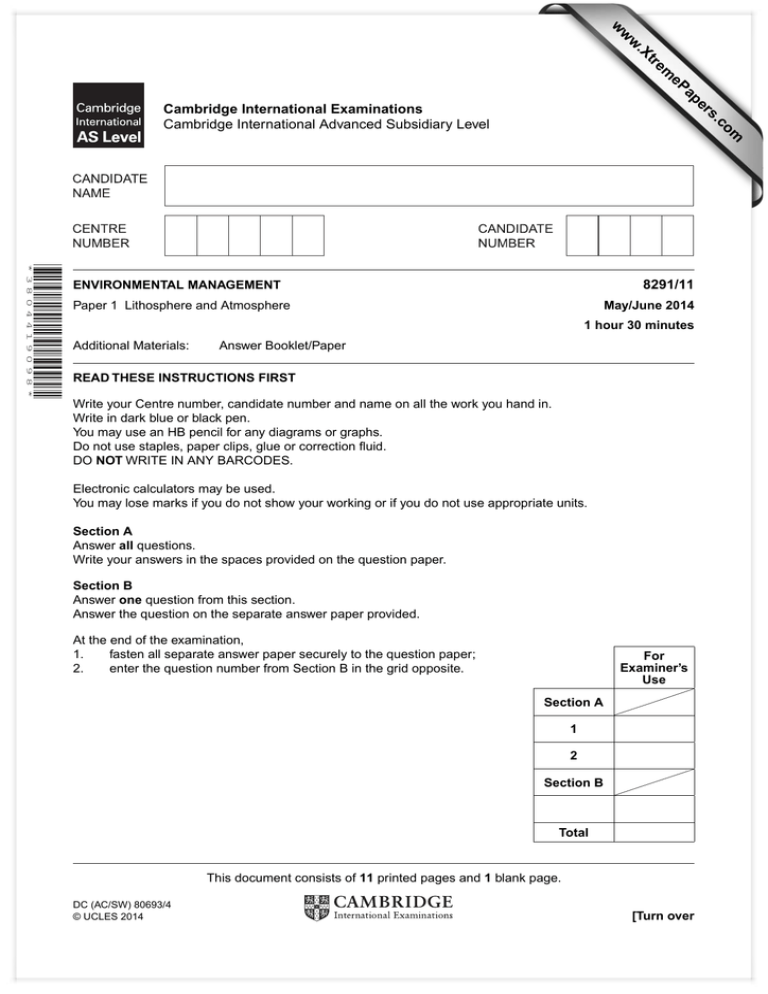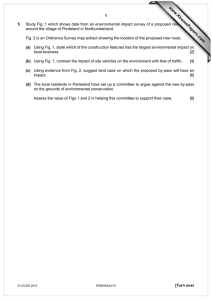www.XtremePapers.com Cambridge International Examinations 8291/11 Cambridge International Advanced Subsidiary Level
advertisement

w w ap eP m e tr .X w om .c s er Cambridge International Examinations Cambridge International Advanced Subsidiary Level * 3 8 0 4 4 1 9 0 9 8 * 8291/11 ENVIRONMENTAL MANAGEMENT Paper 1 Lithosphere and Atmosphere May/June 2014 1 hour 30 minutes Additional Materials: Answer Booklet/Paper READ THESE INSTRUCTIONS FIRST Write your Centre number, candidate number and name on all the work you hand in. Write in dark blue or black pen. You may use an HB pencil for any diagrams or graphs. Do not use staples, paper clips, glue or correction fluid. DO NOT WRITE IN ANY BARCODES. Electronic calculators may be used. You may lose marks if you do not show your working or if you do not use appropriate units. Section A Answer all questions. Write your answers in the spaces provided on the question paper. Section B Answer one question from this section. Answer the question on the separate answer paper provided. At the end of the examination, 1. fasten all separate answer paper securely to the question paper; 2. enter the question number from Section B in the grid opposite. For Examiner’s Use Section A 1 2 Section B Total This document consists of 11 printed pages and 1 blank page. DC (AC/SW) 80693/4 © UCLES 2014 [Turn over 2 Section A Answer all questions in this section. Write your answers in the spaces provided. 1 (a) Fig. 1.1 shows how temperature in the atmosphere changes between 0 and 80 km. mesopause 80 70 tem pe meteor rat u mesosphere re 60 50 height / km stratopause 40 30 stratosphere maximum ozone 20 tropopause 10 Mt. Everest 0 –100 –80 –60 troposphere –40 –20 0 20 40 60 temperature / °C Fig. 1.1 (i) Using the information in Fig. 1.1, state by how much temperature falls between the Earth’s surface and the tropopause. ...................................................................................................................................... [1] (ii) Explain why high air temperatures in Fig. 1.1 are found close to the Earth’s surface. ........................................................................................................................................... ........................................................................................................................................... ........................................................................................................................................... ...................................................................................................................................... [2] © UCLES 2014 8291/11/M/J/14 3 (iii) Suggest why the clouds shown in Fig. 1.1 are normally prevented from rising above the tropopause. ........................................................................................................................................... ........................................................................................................................................... ........................................................................................................................................... ...................................................................................................................................... [2] (iv) Describe one characteristic of the troposphere. ........................................................................................................................................... ........................................................................................................................................... ........................................................................................................................................... ...................................................................................................................................... [2] (b) The ozone layer shown in Fig. 1.1 occurs between 20 and 30 km above the Earth’s surface. (i) Briefly explain how the ozone layer protects life on Earth. ........................................................................................................................................... ........................................................................................................................................... ........................................................................................................................................... ........................................................................................................................................... ........................................................................................................................................... ...................................................................................................................................... [3] (ii) Explain how human activity is believed to be responsible for ozone depletion. ........................................................................................................................................... ........................................................................................................................................... ........................................................................................................................................... ........................................................................................................................................... ........................................................................................................................................... ........................................................................................................................................... ........................................................................................................................................... ...................................................................................................................................... [4] © UCLES 2014 8291/11/M/J/14 [Turn over 4 (iii) Fig. 1.2 shows changes to the shape and size of the hole in the ozone layer over the Antarctic between 1979 and 2011. Fig. 1.3 shows the amount by which ozone has depleted over the Antarctic, between 1979 and 2011. September 17, 1979 0 October 1, 2011 October 7, 1989 100 200 300 total ozone / dobson units 400 Fig. 1.2 250 200 average minimum ozone / dobson units 150 100 10 0 1980 1990 2000 year Fig. 1.3 © UCLES 2014 8291/11/M/J/14 2010 5 To what extent does the data in Fig. 1.2 and Fig. 1.3 support the view that international agreements to reduce damage to the ozone layer have been successful? ........................................................................................................................................... ........................................................................................................................................... ........................................................................................................................................... ........................................................................................................................................... ........................................................................................................................................... ........................................................................................................................................... ........................................................................................................................................... ........................................................................................................................................... ........................................................................................................................................... ........................................................................................................................................... ........................................................................................................................................... ...................................................................................................................................... [6] [Total: 20] © UCLES 2014 8291/11/M/J/14 [Turn over 6 2 (a) Fig. 2.1 shows a cross section through the Earth, with some of the plates labelled. 0°N 25°S mid-oceanic ridge South Atlantic Ocean rift AM SO PLE NAZCA PLATE TRALAUS IAN INDA E PL T Peru trench mid-oceanic ridge AFRICAN PL AT E H N UTICA R TE A Andes 90°E 30°N PL Himalaya AN IF direction of movement oceanic crust SI PA C Key continental crust AT E 90°W 30°S Arabian Sea IC PLA TE EU RA Pacific Ocean Sea of Japan 180°S 25°N Japan trench Fig. 2.1 (i) Using the letters A, B, C and D, write on Fig. 2.1 where you would expect to find the following: subduction ocean floor spreading convection current young fold mountains (ii) A B C D [4] With reference to Fig. 2.1, describe the processes that are responsible for the plates moving. ........................................................................................................................................... ........................................................................................................................................... ........................................................................................................................................... ........................................................................................................................................... ........................................................................................................................................... ........................................................................................................................................... ........................................................................................................................................... ...................................................................................................................................... [4] © UCLES 2014 8291/11/M/J/14 7 (b) Fig. 2.2 shows a cross section through the plate boundary where the North American and Caribbean plates meet. south west north east Montserrat Puerto Rico trench Caribbean Sea Atlantic Ocean + acidic magma rises to surface + as a volcano + + + Caribbean Plate sediments and trapped water aid melting of mantle wedge North American Plate subducted beneath Caribbean plate = 2.2 cm / year not to scale Fig. 2.2 Key + magma rising molten rock (i) Outline the tectonic processes responsible for creating the Puerto Rico ocean trench shown in Fig. 2.2. ........................................................................................................................................... ........................................................................................................................................... ........................................................................................................................................... ...................................................................................................................................... [2] © UCLES 2014 8291/11/M/J/14 [Turn over 8 (ii) Describe the type of volcanic eruptions associated with the island of Montserrat shown in Fig. 2.2. ........................................................................................................................................... ........................................................................................................................................... ........................................................................................................................................... ........................................................................................................................................... ........................................................................................................................................... ........................................................................................................................................... ........................................................................................................................................... ........................................................................................................................................... ........................................................................................................................................... ...................................................................................................................................... [5] (iii) Suggest the strategies that might be adopted to reduce the impact of eruptions such as that shown in Fig. 2.2. ........................................................................................................................................... ........................................................................................................................................... ........................................................................................................................................... ........................................................................................................................................... ........................................................................................................................................... ........................................................................................................................................... ........................................................................................................................................... ........................................................................................................................................... ........................................................................................................................................... ...................................................................................................................................... [5] [Total: 20] © UCLES 2014 8291/11/M/J/14 9 Section B Answer one question from this section. 3 Fig. 3.1 shows the pattern of land use in a rapidly growing LEDC city. Key formal CBDs informal markets commercial zones n industrial zones lil o h port C r e v inner-city slums Ri ac wealthy inner suburbs poorer outer suburbs squatter settlements commuter settlements airport expressway Ri m Rive r Lu rin r R i ve PACIFIC OCEAN Fig. 3.1 (a) Describe the pattern of land use shown in Fig. 3.1. [10] (b) With reference to examples with which you are familiar, assess the effects of urban growth on the city and the surrounding area. [30] [Total: 40] © UCLES 2014 8291/11/M/J/14 [Turn over 10 4 The city of Hong Kong has grown rapidly over the past 25 years. Fig. 4.1 shows the total hours of reduced visibility per year in Hong Kong as a result of air pollution between 1988 and 2009. 1600 1,570 2004 1400 1200 974 1997 total hours of 1000 reduced visibility* 800 per year / hours 600 1,139 2009 727 2001 498 1993 400 * visibility below 8 km in the absence of fog, mist or rain 295 200 1988 0 09 20 07 20 05 20 03 20 01 20 99 19 97 19 95 19 93 19 91 19 89 19 year Fig. 4.1 (a) Describe the trend shown by Fig. 4.1 and outline two likely sources of air pollution in such a densely populated city. [10] (b) With reference to examples from LEDCs or MEDCs with which you are familiar, assess the problems in controlling atmospheric pollution. [30] [Total: 40] © UCLES 2014 8291/11/M/J/14 11 5 Fig. 5.1 is an isoline map which shows anomalies in global air temperatures in January. The temperature anomaly at a particular place is the difference between the temperature of the place and the average temperature for that latitude. +12 0 +12 +8 +8 –8 0 –8 +16 +20 –24 –16 Siberia North +16 Atlantic +12 +8 0 60 °N –12 +4 –4 0 +4 0 –4 –8 30 °N 0 Fig. 5.1 (a) Suggest reasons for the high positive anomaly found in the North Atlantic compared with the high negative anomaly found at the same latitude in Siberia. [10] (b) For one area with which you are familiar, describe and explain the likely impacts of global warming. Explain why it has been difficult to manage these issues on a global scale. [30] [Total: 40] © UCLES 2014 8291/11/M/J/14 12 BLANK PAGE Permission to reproduce items where third-party owned material protected by copyright is included has been sought and cleared where possible. Every reasonable effort has been made by the publisher (UCLES) to trace copyright holders, but if any items requiring clearance have unwittingly been included, the publisher will be pleased to make amends at the earliest possible opportunity. Cambridge International Examinations is part of the Cambridge Assessment Group. Cambridge Assessment is the brand name of University of Cambridge Local Examinations Syndicate (UCLES), which is itself a department of the University of Cambridge. © UCLES 2014 8291/11/M/J/14






